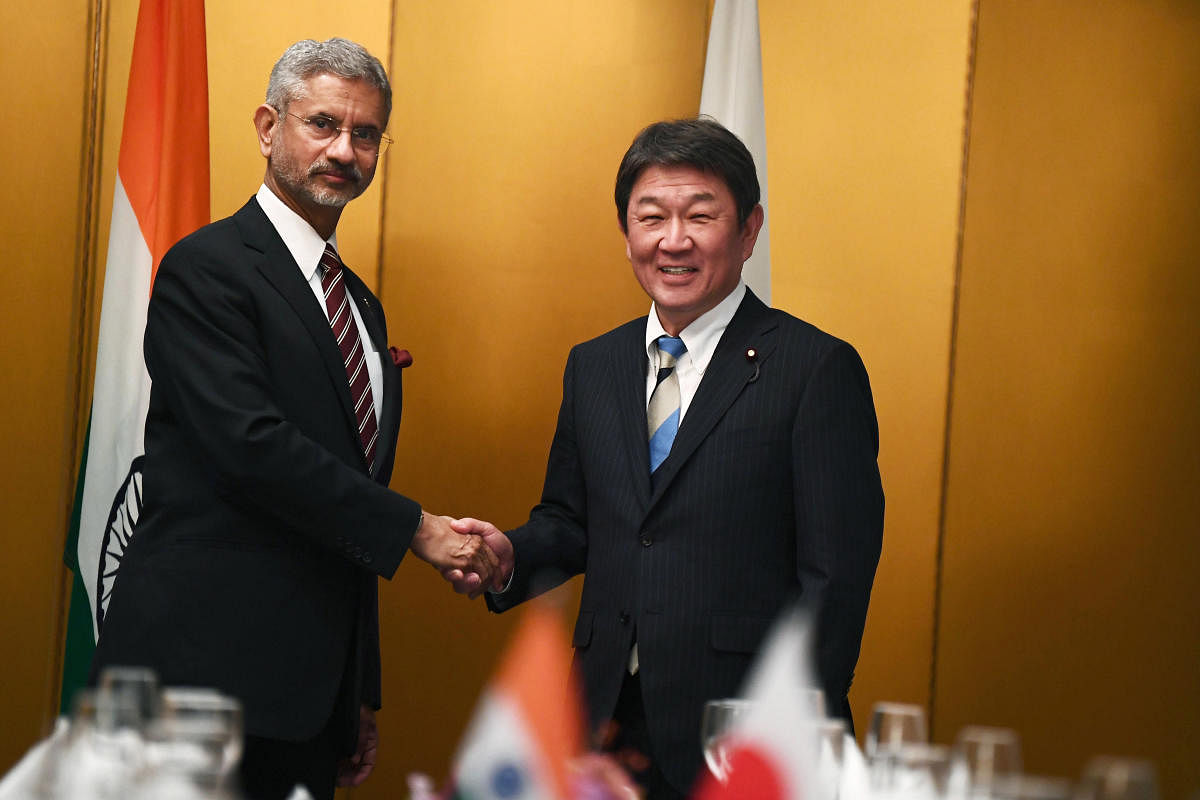
Any deliberations on national security must be drawn parallel to a country’s national growth and political narratives. The upcoming inaugural India-Japan 2+2 ministerial dialogue involving the defence and foreign ministers falls within the prism of such a national construct. The dialogue seeks to enhance the decade-old 2+2 official/vice-ministerial-level dialogue mechanisms between Tokyo and New Delhi. Such a dialogue process advances India-Japan ties by institutionalising the security and foreign policy undercurrents together. Besides, the 2+2 dialogue raises the stature of India-Japan relations regionally, especially ahead of China’s assertive behaviour in the region, and strengthens the Indo-Pacific construct with the US.
Yet, this dialogue must prioritise the changing national narratives of both India and Japan that the leaderships of Shinzo Abe and Narendra Modi are trying to build in domestic constituencies on each side. Under Abe, Japan’s strategic reorientation in Asia is undergoing constant change. This strategic reorientation holds significant implications for most countries, including India, at a time when Japan has moved to ‘Reiwa’ era from its traditional ‘Hensei’ era. ‘Reiwa’ era complements Abe’s nationalist foreign policy, rebuking Chinese traditional link with the Japanese system. Japan under Abe and its future leaders is expected to employ a more autonomist, self-assured and pro-active foreign policy that is central to its quest to regain its lost glory as a power. India should positively perceive such a change, as it boosts a multipolar power structure in Asia.
As Japan’s longest-serving prime minister, Abe has inculcated an India legacy. It was Abe’s 2007 speech in the Indian Parliament on the ‘Confluence of the Two Seas’ that set the tone for the present Indo-Pacific construct. Abe’s return for a third term as PM from 2014-17 coincided with the arrival in India of Modi as PM, translating into a ‘leadership friendship’ that has guided India-Japan ties further. More importantly, since 2017, Abe has revitalized the Quad process, in which India is a strong partner.
Japan under Abe is also pursuing a more independent security thinking. If not entirely a departure from its past ‘alliance structure’ framework of international posture that it strongly shares with the US, Tokyo’s attempt is to explore a new spectrum of security alignments through fresh policies, projects and partnerships, including with India in regional affairs. This complements India’s inclusive Indo-Pacific construct.
Likewise, under Modi, Indian foreign policy narratives have undergone radical changes, imbibing a more nationalist character. A new level of confidence has been built with Tokyo. A 2+2 dialogue with Japan must factor India’s strategic and economic strides. Technology and economic power are two areas that could exemplify India-Japan strategic cooperation.
Technology was, in fact, a focus of discussion during Defence Minister Rajnath Singh’s visit to Tokyo in September. While defence ties between the two sides are on the upswing, technology offers a wide variety of growth points for both. Aside from a small number of joint projects (of which the Delhi metro network, Delhi-Mumbai Industrial Corridor, Mumbai-Ahmedabad High-Speed Rail project and the Western Dedicated Freight Corridor are a few examples) and the acquisition of Indian companies like Camlin by Japanese businesses, the technology business-business cooperation is still very low.
Past ventures between Japan and India have been successful, like Maruti Suzuki’s dominance in the Indian automobile sector and the planned undersea cable from Chennai to Andaman-Nicobar. The 2018 technology partnership between Japan’s National Institute of Advanced Industrial Science and Technology with Indian Institute of Technology, Hyderabad, is focused on major research in Artificial Intelligence (AI) and may expand to 5G and robotics. 5G happens to be a key area of facilitation between the two, and a point of focus at the dialogue. India plans to be an early adopter of 5G technology.
Another possible avenue of discussion is the Osaka Track, a policy proposal by Abe at the G-20 summit, that sought the creation of international guidelines and rules for free movement of data beyond country lines. It is a point of friction between India and Japan as the former is a strong proponent of data localization and has hence refused to sign the statement affirming the Osaka Track. In an otherwise untarnished, uncomplicated and decades-old relationship, it is important for Japan to resolve issues like these at a time when India would be looking for greater international partnership with Tokyo.
Further, the inaugural ministerial dialogue must offer Japan a new context to perceive the Indian defence market afresh. Tokyo hopes to enter the global arms market, abandoning its self-imposed 1967 Arms Export ban, otherwise known as the Three Principles Exports Ban. The rebirth of the Japanese defence industry can only be possible via arms trade.
The negotiations over the Acquisition and Cross-Servicing Agreement (ACSA), which will allow access to bases of the Indian Navy and the Japanese Self-Defense Forces (JSDF) to each other, has brought the requisite confidence, aided by successful maritime exercises. Concrete talks on the Japanese amphibian aircraft, ShinMaywa US-2i and the recent cooperative understanding between India’s Mahindra Defence and ShinMaywa Industries over the same is setting a new benchmark on technology transfer cooperation and joint ventures between the two sides. Also, defence technology-sharing cooperation is moving to a new level between Japan’s Acquisition, Technology and Logistical Agency (ATLA) and India’s Department of Defence Production (DDP).
In the charged geopolitical scenario in the Indo-Pacific and Asia at present, Modi and Abe have formed a strong partnership between their countries, backed by complementary strategic visions of the two countries, and aided not least by the leaders’ personal chemistry. Given all this, the 2+2 dialogue should help strengthen trilateral maritime cooperation, along with the US, such as the joint Malabar exercises. However, with both nations not wanting to pursue an entirely negative approach towards China, it may be the national goals and narratives of the two countries that will provide context for the 2+2 dialogue and ballast to the relationship.
(The writer is Research Fellow and Centre Coordinator for East Asia, Institute for Defence Studies and Analyses, New Delhi)